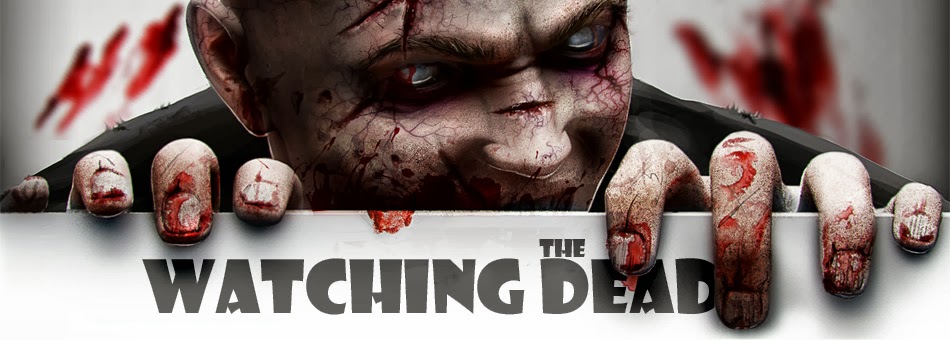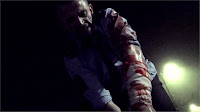Contains spoilers.
Now I know what
you're all thinking. This low, LOW budget shoddy piece of amateur film making
will undoubtedly receive a full zombie beat down where I'll bemoan it for
ambition over ability to deliver, for having a quite awful artistic and
physical presentation and for having woeful b-movie actors forced to work with a contrived hammy
narrative. Well you're right, but you're also kind of wrong. For all its faults which there are
many, the thing I will take away from director / writer / make-up / producer /
line-manager / editor / special effects / camera operator J.R. Bookwalter's
cinematic début is a feeling that here was a genuinely earnest and honest
attempt at a grand zombie opus, and it nearly got it right. Sure, it should
possibly have been a bit more realistic with it's aims; going small and
discrete rather than expansive and ambitious, especially with someone at the
helm who by his own admission had not really even known how to operate a
camera. But really who could really argue against an enthusiastic young eighteen old, who'd just been given
$75,000 by Sam Raimi, who also came on board as executive producer, just going for
it.
 A possibly misguided
attempt at to pay homage to Romero, The Dead Next Door is the tale of a team of
pseudo military cops called The Zombie Squad and their stand as part of the
last line of defence against a world two years consumed by grotesque flesh eating
undead. Pete Ferry is Raimi their leader and he's assigned the mission by
Doctor Moulssson (Bogdan Pecic) to head to ground zero, a research lab run by
the late Doctor Bow (Lester Clark), find his research notes and return so they
can put a stop to the flesh eating viral parasite. To say the acting is the
worst I've probably seen would be exaggerating, but not by much. Whether it's screaming glib and
cliché one word action-film lines or working their way through
tedious contrived exposition designed to tell us the audience who these people are, what they're doing, what's happened to the word and the
compete zombie survival guide a to z, it's amateurish, obvious and badly dubbed in a
Mattei way, yet it's all somehow incredibly earnest and watch-able. And that's the rub. As
the group reach Bow's Lab and come face to face with a strange pseudo
Christian, pro undead, sacrificial death cult lead by the ever weird sunglasses wearing Rev. Jones
(Robert Kokai) and his band of equally weird disciples, the characterisation,
the dialogue and their interaction never gets any better; and yet it somehow manages to never offend as you feel it should.
A possibly misguided
attempt at to pay homage to Romero, The Dead Next Door is the tale of a team of
pseudo military cops called The Zombie Squad and their stand as part of the
last line of defence against a world two years consumed by grotesque flesh eating
undead. Pete Ferry is Raimi their leader and he's assigned the mission by
Doctor Moulssson (Bogdan Pecic) to head to ground zero, a research lab run by
the late Doctor Bow (Lester Clark), find his research notes and return so they
can put a stop to the flesh eating viral parasite. To say the acting is the
worst I've probably seen would be exaggerating, but not by much. Whether it's screaming glib and
cliché one word action-film lines or working their way through
tedious contrived exposition designed to tell us the audience who these people are, what they're doing, what's happened to the word and the
compete zombie survival guide a to z, it's amateurish, obvious and badly dubbed in a
Mattei way, yet it's all somehow incredibly earnest and watch-able. And that's the rub. As
the group reach Bow's Lab and come face to face with a strange pseudo
Christian, pro undead, sacrificial death cult lead by the ever weird sunglasses wearing Rev. Jones
(Robert Kokai) and his band of equally weird disciples, the characterisation,
the dialogue and their interaction never gets any better; and yet it somehow manages to never offend as you feel it should.  The cultists don't
like the soldiers and the soldiers don't like what the cultists are doing so
they inevitably clash with guns, grenades and rhetoric. The action moves along
at fairly nice pace and along the way there's a good amount of blood, guts and imaginative
and original zombie set pieces,
especially at the cultists lair and the manner in which they're a) being
protected and b) being used as a weapon in a manner not all too dissimilar to
that employed by the Governor some twenty years later. It does suffer from all
too contrived and needlessly uber-stupid
behaviour for many of the totally avoidable zombie bites and whether it's
accidental fingers put zombies mouths, or mucking about with electric windows each kill is lazy and distracts from the generally good amateur effects
that ensue.
The cultists don't
like the soldiers and the soldiers don't like what the cultists are doing so
they inevitably clash with guns, grenades and rhetoric. The action moves along
at fairly nice pace and along the way there's a good amount of blood, guts and imaginative
and original zombie set pieces,
especially at the cultists lair and the manner in which they're a) being
protected and b) being used as a weapon in a manner not all too dissimilar to
that employed by the Governor some twenty years later. It does suffer from all
too contrived and needlessly uber-stupid
behaviour for many of the totally avoidable zombie bites and whether it's
accidental fingers put zombies mouths, or mucking about with electric windows each kill is lazy and distracts from the generally good amateur effects
that ensue.
There's a mad
scientist, isn't there always, and he's inadvertently unleashed an infectious
virus on the world that kills its host then continues to hunger for nutrition
to sustain its life. It's actually probably most similar to World War Z; the
idea that the hosts become vessels to propagate the spread of the virus and
require flesh to keep going. Without sustenance, the undead drop after
about three months, but with so many tasty morsels as so if often the case when something does global, the virus was able to stay
alive and spread. Interestingly Bookwalter also used The Return of the Living Dead total reanimation idea, though who was first will have to left
open (ROTLD came out in '85 / TDND started shooting in '85). The virus keeps
whatever part of its host going, albeit until it runs out of juice, so head
shots, decapitation all help slow the zombies down but they're not a permanent
solution. Bookwalter also brings to the table a solution of sorts. Moulsson,
with the help of Bow's research concocts a formula that can speed up the viral
process so that the corpses burn out in hours not months and that leads to some
nice melting zombie scenes and the concept of zombie/human hybrid fusions, that are neither alive or undead, but pretty grotesque, violent and quite coherent
all the same.
 Don't get me wrong,
The Dead Next Door is out and out poor b-movie film making, but I'm starting to
think I secretly hold quite the candle for earnest amateur horror, especially
zombie rubbish as my recent euro-trash reviews would attest. As contrived as the story is, the tussle over
Dr. Bow's research and the pro-zombie stand off was at least original and
mostly held together as long as one is willing to look past all the inconsistencies. whilst not a comedy, there were a few deliberate and non-deliberate laughs and even the attempts at the odd bit of satire, though this could never be called a deep film (watching petty bureaucracy survive as Moulsson is forced to sign for zombie specimens, and the attack on the pro-zombie protesters were personal highlights.)
Don't get me wrong,
The Dead Next Door is out and out poor b-movie film making, but I'm starting to
think I secretly hold quite the candle for earnest amateur horror, especially
zombie rubbish as my recent euro-trash reviews would attest. As contrived as the story is, the tussle over
Dr. Bow's research and the pro-zombie stand off was at least original and
mostly held together as long as one is willing to look past all the inconsistencies. whilst not a comedy, there were a few deliberate and non-deliberate laughs and even the attempts at the odd bit of satire, though this could never be called a deep film (watching petty bureaucracy survive as Moulsson is forced to sign for zombie specimens, and the attack on the pro-zombie protesters were personal highlights.)
Alas a good film this
is not, and I certainly wouldn't recommend it for any kind of casual viewing, but if you like good b-movies and appreciate sincere,
industrious, if incredibly flawed attempts at zombie horror you might find, like I did, that you enjoy this far more than you feel you probably should, 6/10.
Steven@WTD.






































